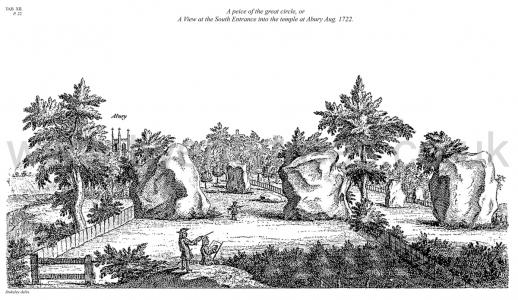Avebury Chapter IV
Avebury Chapter IV is in Avebury A Temple of British Druids, With Some Others, Described by William Stukeley.
The figure of the temple of Abury is a circle and snake. Hakpen [Map], another oriental word still preserved here, meaning the serpent's head. The chorography of Abury. A description of the great circle of stones 1400 foot in diameter. Of the ditch inclosing it. The vallum formed on the outside, like an amphitheater to the place. This represents the circle in the hieroglyphic figure. Of the measures, all referring to the ancient eastern cubit which the Druids used.
THE situation of Abury is finely chose for the purpose it was destined to, being the more elevated part of a plain, from whence there is an almost imperceptible descent every way. But as the religious work in Abury, tho' great in itself, is but a part of the whole, (the avenues stretching above a mile from it each way,) the situation of the intire design is likewise projected with great judgment, in a kind of large, separate plain, four or five miles in diameter. Into this you descend on all sides from higher ground. The country north of Abury, about Berwick-basset and Broad Hinton, is very high, tho' not appearing so to be, and much above the level of Abury town. In a field of Broad Hinton the water runs two ways, into the Thames and Severn, and they pretend 'tis the highest ground in England. 'Tis indeed part of that very great ridge of hills, coming from Somersetshire, and going hence north-eastward, to the white-horse hill. So that the ground northward and westward, tho' not much appearing so, is still very high, a cliff descending that way; and whilst guarded to the east by the Hakpen [Map], yet it may be called like the thessalian, of the same name,
—Zephyris agitata Tempe. Hor.
[Tempe, stirred by western winds. The western winds being Zephyris. Horace Odes Book 3 Poem 1]
The whole temple of Abury may be considered as a picture, and it really is so. Therefore the founders wisely contrived, that a spectator should have an advantageous prospect of it, as he approached within view. To give the reader at once a foreknowledge of this great and wonderful work, and the magnificence of the plan upon which it is built, I have designed it scenographically in Table VIII. the eye being somewhat more elevated than on the neighbouring hill of Wansdike, which is its proper point of sight, being south from it.
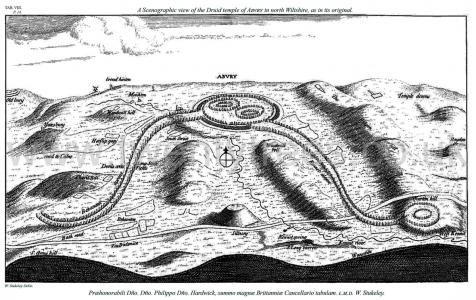
When I frequented this place, as I did for some years together, to take an exact account of it, staying a fortnight at a time, I found out the entire work by degrees. The second time I was here, an avenue was a new amusement. The third year another. So that at length I discovered the mystery of it, properly speaking; which was, that the whole figure represented a snake transmitted thro' a circle; this is an hieroglyphic or symbol of highest note and antiquity.
In order to put this design in execution, the founders well studied their ground; and, to make their representation more natural, they artfully carryed it over a variety of elevations and depressures, which, with the curvature of the avenues, produces sufficiently the desired effect. To make it still more elegant and picture-like, the head of the snake is carried up the southern promontory of the Hakpen hill [Map], towards the village of West Kennet; nay, the very name of the hill is derived from this circumstance, meaning the head of the snake; of which we may well say with Lucan, lib. IV.
Hinc ævi veteris custos, famosa vetustas
Miratrixque sui signavit nomine terras,
Sed majora dedit cognomina collibus istis.
[Hence the keeper of the old age, the famous antiquity, And the wonder of himself signed the name of the lands, But he gave greater names to these hills]
Again, the tail of the snake is conducted to the descending valley below Bekamton.
Table X. Prospect of the Roman Road & Wansdike Just above Calston May 20. 1724. This demonstrates that Wansdike was made before the Roman Road.
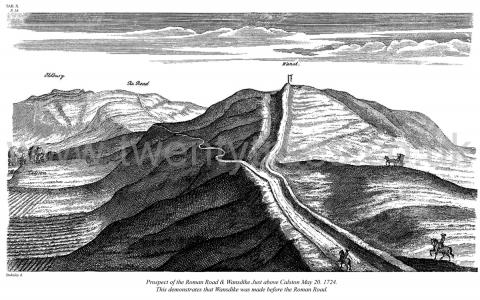
Thus our antiquity divides itself into three great parts, which will be our rule in describing the work. The circle at Abury, the fore-part of the snake, leading towards Kennet, which I call Kennet-avenue; the hinder part of the snake, leading towards Bekamton, which I call Bekamton-avenue; for they may well be looked on as avenues to the great temple at Abury, which part must be more eminently called the temple.
This town is wrote Aubury, Avebury, Avesbury, sometimes Albury: 'tis hard to say which is the true. The former three names may have their origin from the brook running by, au, aux, water, awy in welsh; the old german aha. The latter points to Aldbury, or old work, regarding its situation within the vallum. Nor is it worth while to dwell on its etymology; the saxon name is a thing of so low a date, in comparison of what we are writing upon, that we expect no great use from it; unless Albury has regard to al, hal, healle, gothicè a temple or great building. There are two heads of the river Kennet rising near it: one from a little north-west of Abury, at Monkton, runs southward to Silbury-hill; this affords but little water, except in wet seasons. At Silbury-hill it joins the Swallow head, or true fountain of the Kennet, which the country people call by the old name, Cunnit; and it is not a little famous among them. This is a plentiful spring. It descends between east and west Kennet, by the temple on Overton-hill, which is properly the head of the snake: it passes by Overton, and so to Marlborough [Map], the roman Cunetio, which has its name from the river.
To conduct the reader the better through this great work, I must remind him of what I wrote in the account of Stonehenge, p. 11, concerning the Druid cubit or measure, by which they erected all their structures, that 'tis 20 inches and four fifths of the english standard. For this purpose I have repeated the plate wherein the english foot and Druid cubit is compared to any lengths, which must necessarily accompany us in the description. A ready way of having the analogism between our feet and the cubits is this, 3 foot 5 inches and a half makes 2 cubits. A staff of 10 foot, 4 inches, and a little more than half an inch, becomes the measuring-reed of these ancient philosophers, being 6 cubits, when they laid out the ground-plot of these temples; where we now are to pursue the track of their footsteps which so many ages have passed over.
The whole of this temple, wherein the town of Abury is included I have laid down in Table I, the frontispiece, done from innumerable mensurations, by which means I fully learned the scheme and purport of the founders. 'Tis comprehended within a circular ditch or trench above 1400 foot in diameter, which makes 800 cubits, being two stadia of the ancients. A radius of 400 cubits, one stadium, struck the inner periphery of the ditch, in the turf. This is done with a sufficient, tho' not a mathematical exact20ness. They were not careful in this great measure, where preciseness would have no effect, seeing the whole circle cannot be taken in by the eye on the same level. The ditch is near 80 foot, which is 45 cubits broad, very deep, like the foss that encompasses an old castle. The great quantity of solid chalk dug out of it, is thrown on the outside, where it forms a mighty vallum, an amphitheatrical terrace, which hides the sight of the town as we come near it, and affords a good shelter from the winds. 'Tis of the same breadth at bottom as the ditch at top. The compass of this, on the outside, Mr. Roger Gale (age 50) and I measured about 4800 feet, August 16, 1721.
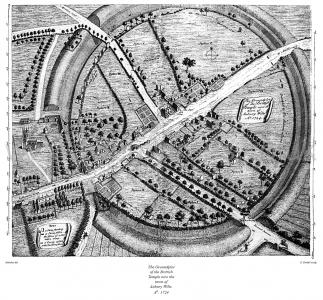
The included area of the temple containing about 22 acres, I observed to have a gentle descent, from the meridian line of it to the east, and to the west: carrying the rain off both ways. The north point is the highest part of the whole. About 35 feet or 20 cubits within the verge of this circular ditch, is a great circle of great stones. The epithet may well be redoubled. These great masses are really astonishing, if we contemplate a single stone, and consider how it was brought hither, and set upright in the ground, where it has stood, I doubt not, 3 or 4 thousand years. But how is the wonder heightened, when we see the number one hundred, which composes this mighty circle of 1300 foot diameter! The stones of this circle, tho' unhewn, are generally about 15, 16, or 17 foot high, and near as much in breadth. About 43 English feet, measures regularly from the center of one stone, to the center of the other. Look into the scale and we discern these measures of the height and breadth of the stones. 17 feet is ten cubits; 43 feet the central distance from stone to stone, is 25 cubits of the Druids; so that the interval between is 15 cubits. Tho' this be the general and stated measure, which was proposed by the founders, where the stones suited, and of the largest dimensions, yet we must understand this, as in all their works, with some latitude. The ancients studied a certain greatness: to produce an effect, not by a servile exactness no way discernible in great works, but in securing the general beauty; especially we must affirm this of our Druids, who had to do with these unshapely masses, and where religion forbad them applying a tool. But the purpose they proposed, was to make the breadth of the stone to the interval, to be as two to three. They very wisely judged that in such materials, where the scantlings could not be exact, the proportions must still be adjusted agreeable to their diversities, and this both in respect of the particulars, and of the general distance to be filled up. These stones were all fetched from the surface of the downs. They took the most shapely, and of largest dimensions first; but when 'twas necessary to make use of lesser stones, they set them closer together, and so proportioned the solid and the vacuity, as gave symmetry in appearance, and a regularity to the whole.
Therefore tho' 25 cubits be the common measure of the interval between center and center of the largest stones of this circle, yet this is not always the rule; for if we measure the two stones west of the north entrance (which entrance was made for the convenience of the town, by throwing the earth of the vallum into it again) you will find it to be about 27 feet. This is but 16 of the Druid cubits, and here used, because these stones are but of moderate bulk. The next intervals are 43 feet as usual, being of the larger kind of stones, so placed 25 cubits central distance, and then they proceed. This is in that called pasture IIII. in the ground plot.
I have always been at first in some perplexity in measuring and adjusting these works of the Druids, and they seemed magical, 'till I became master of their purpose. Therefore to make it very plain to the reader, I shall repeat what I have delivered in other words, concerning this great circle, which is a general rule for all others.
18 Jul 1728. Table XI. Rundway hill 18 July, 1723. A. Bekhampton. B. the Model of a Camp. C. Celtic barrows. D. the way to Verlucio. [The drawing shows Silbury Hill [Map] and Cherhill aka Oldbury Hill Fort [Map]]
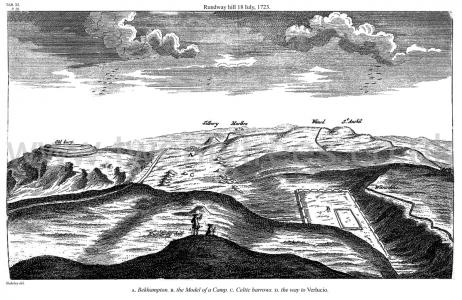
As to the construction of this circle, by diligent observation, I found this to be the art of the Druids. 'Tis not to be thought, they would be at the trouble of bringing so many mountains together, of placing them in a regular form, without seeking how to produce the best effect therein, and thus they obtained their purpose. As it was necessary, the stones should be rude and native, untouched of tool, and that it was impossible to procure them of the dimensions exactly; they considered that the beauty in their appearance must be owing to their conformity, as near as may be, and to the proportion between the solid and the void interval. This ratio with judgment they chose to be as two to three: two parts the breadth of the stone, the interval three. And this they accommodated to the whole circle. So that they first brought 100 of their choicest stones together, and laid them in the destined circle, at the intended distances, according to that proportion: and then raised them into their respective places.
Hence I find, that where the stones are 15, 16, or 17 feet high above ground, and as much broad, as for the most part they are, about 43 English feet measures, from the center of one stone to the center of another; there the square of the solid or stone is ten cubits, the void or interval is 15: the whole central distance 25. Therefore the proportion of the solid to the void is as two to three.
But before I found out this key to the work, I met with a good deal of difficulty, because the central intervals and the voids were different, for they proportioned these to the breadths of the stones, as above. Still they chose whole numbers of cubits for that proportion; for instance, in the stones at the northern and modern entrance, where they are but of a moderate bulk, you measure but about 27 feet central distance. This is 16 cubits.
Further I observed, they took care to make a reasonable gradation, between greater and lesser stones, not to set a great stone and a little one near one another, but make a gradual declension; by this means in the whole, the eye finds no difference. The proportion of solid and void being the same, the whole circle appears similar and altogether pleasing.
I thought it adviseable to give a plate of a very small part of this magnificent circle, being 3 stones now standing in situ. 'Tis a most august sight, and whence we may learn somewhat of the appearance of the whole.
I observed further, that as these stones generally have a rough and a smoother side; they took care to place the most sightly side of the stone inwards, toward the included area. For this vast circle of stones is to be understood, as the portico inclosing the temple properly. Between this circle and the ditch is an esplanade or circular walk quite round, which was extraordinary pretty when in its perfection. It was originally 25 cubits broad, equal to the central distances of the stones. The quickset hedges now on the place, sometimes take the range of the stones, sometimes are set on the verge of the ditch. Further I observed they set the largest and handsomest stones in the more conspicuous part of the temple, which is that southward, and about the two entrances of the avenues.
Out of this noble circle of stones 100 in number, there was left in the year 1722, when I began to write, above 40 still visible: whereof 17 were standing, 27 thrown down or reclining. Ten of the remainder all contiguous, were at once destroyed by Tom Robinson, anno 1700, and their places perfectly levelled, for the sake of the pasturage. In the north entrance of the town one of the stones, of a most enormous bulk, fell down, and broke in the fall.
nec ipso monte minor procumbit. Virg.
[nor does the minor prostrate himself on the mountain itself Virgils Georgics III]
It measured full 22 feet long. Reuben Horsall, clerk of the parish, a sensible man and lover of antiquity, remembers it standing. And when my late lord Winchelsea (Heneage) was here with me, we saw three wooden wedges driven into it, in order to break it in pieces.
In the great frontispiece plate, I have noted many dates of years, when such and such stones were demolished, and took down the particulars of all: some are still left buried in the pastures, some in gardens. I was apt to leave this wish behind;
Pro molli viola, pro purpureo narcisso
Carduus, & spinis surgat paliurus acutis! Virg.
[for tender violet and narcissus bright. Virgil's Eclogues 5.]
The seat of many is visible by the remaining hollow; of others by a hill above the interred. Of many then lately carryed off the places were notorious, by nettles and weeds growing up, and no doubt many are gone since I left the place. But the ground-plot representing the true state of the town and temple, when I frequented it, I spare the reader's patience in being too particular about it.
When this mighty colonnade of 100 of these stones was in perfection, there must have been a most agreeable circular walk, between them and the ditch; and it's scarce possible for us to form a notion of the grand and beautiful appearance it must then have made.
Table XII. A piece of the great circle, or A View at the South Entrance [Map] into the temple at Abury Aug. 1722.
